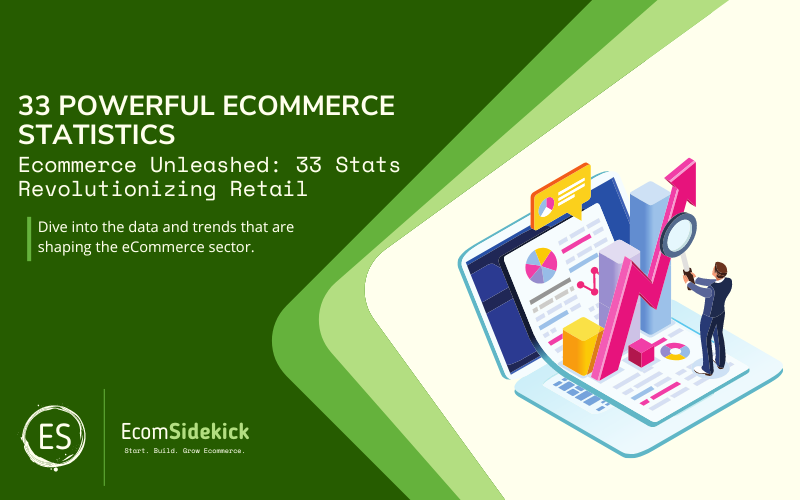Online shopping has become a cornerstone of how we use the internet. Ecommerce has expanded to cover a massive range of services, and with just a click of a button, we can get most of our favorite products delivered directly to our door.

For ecommerce business owners, the growing marketplace is both a help and a hindrance. Take a look at these 33 powerful ecommerce statistics to learn more about the industry, and the role you can play in it.
1. Global Ecommerce Sales Are Forecasted To Reach 8.1 Trillion USD By 2026
More and more money looks set to pass through ecommerce, as shoppers become increasingly comfortable with digital platforms, and people get connected globally. If ecommerce sales reach 9 trillion by 2026, this would be roughly a 56% growth from 2021.
(Statista)
2. China Alone Is Expected To Reach 3.3 Trillion USD By 2025
China is the major player in ecommerce, with sales set to reach 3.3 trillion USD by 2025. Between 2017 and 2021, Chinese ecommerce sales grew by 17.7% to 2.1 trillion USD.
3. Ecommerce Sales Are Expected To Account For 23.4% Of Total Retail Sales By 2023
Ecommerce is expected to take an increasingly large share of total retail sales by 2023, rising to 23.4% from 20.7% in 2021. Is there an end to the growth? It’s difficult to say, but with South Korea ecommerce sales accounting for 35% of retail sales, there’s still plenty of room for expansion.
(CBRE)
4. There Are Estimated To Be Between 12 And 24 Million Online Stores Worldwide
It’s hard to determine the exact number of ecommerce stores worldwide, especially as the market is rapidly changing. Estimates put the number of ecommerce stores anywhere between 12 and 24 million, with many more expected to join the party in coming years.
5. Digital-Impacted Retail Sales Are Expected To Account For 58% Of Total Retail Sales By 2023
Digital-impact sales include sales made in-store, by consumers who researched the products online. This continued growth shows that ecommerce doesn’t account solely for purchases made online, and ecommerce stores can influence brick and mortar sales.
(CBRE)
6. Smartphone Shoppers Dominate The Ecommerce Landscape
Most visitors browse and shop from their mobile phones, with smartphones accounting for 71% of retail site traffic, and 61% of transactions. A mobile-friendly website can encourage shoppers to use your store, while app-based shopping is increasingly prominent.
(Statista)
7. Nearly Half Of Shoppers Use Smartphones In Retail Stores
It isn’t just online purchases that benefit from the smartphone: retail stores are also seeing an increase in mobile shoppers. 46.8% of shoppers use their phone in store to look for discounts and coupons, while 43.3% look up product information.
(PYMNTS)
8. The Global Average Order Value Is $106
Across the world, shoppers are spending an average of $106 on each shop. The luxury & jewelry market sees the highest average order value of roughly $191, while home & furniture sees the lowest, of just $56.
9. 75% Of Global Shoppers Are influenced By Free Shipping
We all love getting things for free, and more and more shoppers are expecting free shipping, at least with a certain amount purchased. However, think carefully before adding free shipping to your ecommerce store, as the logistics can bite at your bottom line.
(Shopify)
10. An Average Shopper Buys Three Things In Each Order
Most shoppers across the globe put 3 things in their cart when they shop online (3.02, to be precise). The largest shopping baskets are found in food & beverage, where an average of 5.08 units are sold per transaction. And shoppers in Asia-Pacific are the most likely to buy more items in one go: 3.08.
11. People Shop From Unusual Places
One of the many benefits of ecommerce is you can do your shopping from wherever you feel comfortable. And consumers are making the most of that! 43% of Americans who have shopped online are said to have made a purchase while tucked up in bed.
12. Social Media Is Increasingly Prominent In Buyer’s Choices
Consumers are becoming increasingly likely to buy products directly from social media, with rising giant TikTok playing a key role in this trend. 62% of shoppers reported that they’d buy directly from YouTube, while 48% of shoppers would buy directly from TikTok, a huge leap from the start of 2022!
13. The Influencer Marketing Industry Is Set To Reach 16.4 Billion USD
It’s impossible to ignore the rise of the influencer, and their importance in ecommerce trends. Brands are sitting up and taking notice, with 75% of marketers intending to dedicate part of the budget to influencer outreach. 54% of brands who work with influencers own an ecommerce store.
14. Positive Customer Experiences Make 94% Of Shoppers More Likely To Purchase Again
If you’re a hands-off business owner who believes the product is good enough to speak for itself, you might be losing customers. Good customer service overwhelmingly encourages shoppers to return to an ecommerce store, and to recommend that company to a friend.
15. Amazon Is The Top Ecommerce Company In The World

Amazon truly is a giant of the ecommerce world, which should come as no surprise to anyone who has spent time online. At the start of 2022, Amazon’s market value topped $1.600 trillion USD. But shoppers in China turn elsewhere: Alibaba is the major player in the Chinese ecommerce market.
(Oberlo)
16. In 2021, Amazon Sold 600 Billion USD Of Goods
It’s easy to see why Amazon is dominant when you take a look at the number of goods passing through the platform. In 2021, the total gross merchandise volume sold on Amazon exceeded $600 billion, including $390 billion from Amazon Marketplace.
17. China, The US, And The UK Are The Top Ecommerce Markets
China and the US dominate the ecommerce market, as between them, they account for over 50% of all online sales. The United Kingdom, Japan, and South Korea round out the top 5. And these 5 are expected to stay on top until 2025.
(Shopify)
18. 6 In 10 Internet Users Buy Something Online Every Week
58.4% of working age internet users buy something online every week, and that number rose throughout 2021. Shoppers aren’t just spending more online, they’re also doing it more frequently. 28.3% of working age internet users bought their groceries online weekly.
19. WooCommerce Is The Most Popular Ecommerce Platform
Ecommerce shops hosted on WooCommerce account for 29% of all ecommerce websites, and 3.97% of all websites on the internet as a whole. 7% of online sales across the world are made on shops hosted by WooCommerce.
You will want to note other ecommerce platforms that can work well in your tech stack. Here are a few comparisons to look at.
20. Shopify Grew Almost 50% In 2021
WooCommerce has a close competitor in Shopify, which saw a 50% rise in 2021. As people were locked inside during the covid pandemic, more turned towards ecommerce to make an income. And Shopify was there to support (and host) more than $1 billion dollars in Merchant Solutions revenue in just a single quarter.
(Shopify)
Some related articles comparing Shopify vs other platforms may be helpful here:
21. Nearly 70% Of Online Shopping Carts Are Abandoned
One of the major issues faced by ecommerce business owners is getting shoppers to complete a purchase. 69.99% of carts are abandoned before a sale is made, although 58.6% of shoppers in the US claim they were never planning to make a purchase anyway.
(Baymard)
22. And Mobile Shoppers Are More Likely To Abandon A Cart
The smaller the screen, the happier shoppers are to abandon a cart. Roughly 80% of carts on mobile devices are abandoned. Considering more shoppers are using smartphones for digital browsing, this is perhaps an expected trend.
23. Most People Abandon Their Carts Because Of Extra Costs
So, why are shoppers giving up on their full carts? 48% of shoppers abandon their carts because the final amount was more than expected. This might be because of shipping costs, taxes or additional fees. 24% of shoppers abandoned carts because they were required to make an account before purchase.
(Baymard)
24. 67% Of Shoppers Check The Returns Policy Before Buying
Ecommerce generates a much higher returns rate than retail stores: 30% compared to 8.89%. If returns are easy, 92% of consumers will buy an item again. Shoppers also buy with the intent to return (if necessary). 67% of shoppers check the returns page before committing to a purchase.
25. Shoppers Expect Personalization
Online shopping can often feel like a distant process, taking place behind screens with little human interaction. Consumers are now expecting a more personal service, and organizations are working to foster a sense of intimacy. But get it wrong, and you might lose business.
(McKinsey)
26. U.S. Shoppers Are Shifting Towards Buy Now, Pay Later Services
Buy Now, Pay Later services have been a fast-growing trend in Europe, and U.S. shoppers are starting to take notice. European brand Klarna is a leader in this area. By targeting Buy Now, Pay Later sales, businesses can attract customers who appreciate a flexible approach to shopping.
(Forbes)
27. But Credit Cards Still Dominate Worldwide
Even as new payment methods gain a greater role in the market, the credit card remains the dominant force worldwide. 53% of global ecommerce transactions are made on a credit card.
(Kinsta)
28. Luxury Brands Are Excited By NFTs
The digital marketplace never stays still, and NFTs are the latest example of this. A crypto-backed market that exploded in 2021, NFTs have already caught the eye of luxury brands such as Gucci, Balmain, and Burberry.
29. And Online Playgrounds Might Be A Way To Attract Younger Shoppers
Gen Z are making their way into the marketplace, and these younger shoppers are experts of ecommerce. So, how to stand out? Several brands, including Nike and Vans, have turned to the digital world of Roblox to generate sales and interest.
30. 67% Of Shoppers Have Made A Cross-Border Purchase

Cross-border purchases, in which shoppers buy products from ecommerce stores in other countries, is a growing trend. 67% of shoppers have purchased from stores outside their home country, with most cross-border customers located in Brazil.
(Flow.io)
31. 40% Of Shoppers Won’t Buy From Websites In Other Languages
The key to attracting cross-border shoppers might be expanding your language choices. 40% of shoppers won’t buy from websites in other languages, while 65% prefer content in their own language, even if it’s a poor quality translation.
32. B2B Ecommerce is Expected To Grow
Business-to-business ecommerce is an emerging trend in digital sales. By 2023, an estimated 17% of B2B sales are predicted to be made digitally, up from 13% in 2019. B2B shoppers, like the rest of us, appreciate the ease of digital shopping.
(Statista)
33. The Ecommerce Boom Looks To Be Slowing
Unsurprisingly, as the world moves away from covid lockdowns and back into retail stores, the ecommerce boom looks to be slowing slightly. But that doesn’t mean ecommerce is on its way out. Instead, ecommerce is expected to grow, even if not at the rapid rate of expansion observed in 2021.
Ecommerce Statistics: Final Thoughts
Ecommerce continues to expand, with more shoppers using digital platforms not only to make purchases, but to compare products and browse items. Ecommerce business owners will have to find new ways to stand out in the marketplace, with customer service becoming a priority.
Frequently Asked Questions
What Are Some Key E-commerce Statistics That Showcase the Growth of Online Shopping?
E-commerce has experienced significant growth in recent years. Statistics can include the total value of global online sales, the increasing number of online shoppers, and the rise of mobile commerce.
How Has the COVID-19 Pandemic Impacted E-commerce?
The pandemic accelerated the shift to online shopping, with many consumers turning to e-commerce due to lockdowns and social distancing measures. Statistics may show the surge in e-commerce sales during this period.
What Percentage of Retail Sales Are Attributed to E-commerce?
E-commerce’s share of total retail sales varies by country and region. Statistics can highlight the percentage of retail sales that come from online purchases.
Paul Martinez is the founder of EcomSidekick.com. He is an expert in the areas of finance, real estate, eCommerce, traffic and conversion.
Join him on EcomSidekick.com to learn how to improve your financial life and excel in these areas. Before starting this media site, Paul built from scratch and managed two multi-million dollar companies. One in the real estate sector and one in the eCommerce sector.

